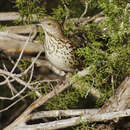Comprehensive Description
provided by Smithsonian Contributions to Zoology
Toxostoma rufum (Linnaeus)
Experiments showed this species to be a rejecter. Artificial or real cowbird eggs were ejected from 25 nests and accepted at only 1 (Rothstein, 1975a). These experiments were conducted in Connecticut, Nebraska, Michigan, and Manitoba. It was not previously known that the brown thrasher typically ejects cowbird eggs but there are at least 5 known cases in which naturally deposited cowbird eggs disappeared from thrasher nests (see Rothstein, 1975a, and Graber, Graber, and Kirk, 1970:30). In 1 instance reported by Mengel and Jenkinson (1970) the investigators believed that the cowbird rather than the thrashers removed the cowbird egg. But because Mengel and Jenkinson did not actually see the cowbird remove her own egg and because their belief is based on only 1 nest, their suggestion that cowbirds remove their own eggs is in need of further substantiation. Whether thrashers alone or cowbirds and thrashers remove cowbird eggs, it is clear that the amount of parasitism detected is only a fraction of the actual parasitism that occurs. Graber, Graber, and Kirk (1970) detected parasitism at 2 percent of all brown thrasher nests in their study area of northern Illinois. This sounds like a very low figure until the biases are accounted for. The 2 percent of thrasher nests recorded as parasitized were probably ones at which acceptance (as well as parasitism) occurred; parasitism was unlikely to have been detected at other nests where ejection occurred. The experiments cited above showed that acceptance occurs at only 1 in 26 nests. This means that if each of the 2 percent of the nests recorded as parasitized was an acceptance, then the actual rate of parasitism was about 26 times as high, or 52 percent. If only half the nests observed to be parasitized resulted finally in acceptances, then the actual rate of parasitism was 26 percent.
The brown thrasher is the only rejecter species discovered so far that may on occasion have difficulty distinguishing between its eggs and those of the cowbird. Thrasher eggs are larger and are evenly marked with fine speckles throughout their surface while cowbird eggs have fewer but larger speckles that are often concentrated at the wider pole. Unusually large cowbird eggs with a thrasherlike maculation, however, are sometimes found (S.I.R., pers. observ.). If thrashers, on occasion, have difficulty distinguishing cowbird eggs from their own eggs, then the experiments may have slightly overestimated the rate of rejection that would occur in natural parasitism because the artificial and real cowbird eggs used in the experiments were strongly distinct from thrasher eggs. The experiments, however, still provide a reliable measure of the frequency of thrasher nests at which rejection of nonmimetic eggs occurs. P. F. Elliott, moreover, has informed us that in Riley County, Kansas, in 1974 and 1975, 3 of 8 brown thrasher nests were parasitized and in none of them were the cowbird eggs ejected. One nest fledged 3 thrashers and a cowbird.
Throughout the total range of the brown thrasher the number of observed cases of parasitism reported shows a growth from 31 in 1963, to 79 in 1975. The fact that this species is known to be a rejecter makes it probable that it is parasitized considerably more frequently than the relatively small number of records indicate (relative, that is, to the total number of nests found by observers). The nest records at Cornell University show 15 instances of parasitism among 1038 nests reported. These are distributed as follows: Kansas 2, Maryland I, Michigan 1, Minnesota 1, Missouri 2, Nebraska 4, New York 2, Wisconsin 2. The Ontario nest record files at Toronto include 14 such cases out of 484 nests reported. The collections of the Western Foundation have 156 sets of eggs of this bird, 3 of which (1.9 percent) were parasitized. Indeed, if we may cite negative evidence, it seems that thrashers generally are not molested to any degree by the brown-headed cowbird. Some 9 species of thrashers are sympatric in their breeding range with the cowbird, but the brown thrasher is the only one for which there are numerous records of parasitism. Three other species of Toxostoma (T. longirostre, T. bendirei, and T. curvirostre) and 1 of Oreoscoptes (O. montanus) have but a single record apiece; the other 4 species of Toxostoma (T. redivivum, T. lecontei, T. dorsale, and T. occelatum) have never been reported as cowbird victims. We have no information as to the reactions (accepter or rejecter) of any of these species except T. lecontei, which is an accepter (S.I.R., unpublished experiments).
Lest it seem that the paucity, or absence, of instances of cowbird parasitism on thrashers of the genus Toxostoma, other than T. rufum, be due to small numbers of nests found, it may be mentioned that the Western Foundation's collections contain the following large series of sets of eggs, all from areas of sympatry with the brown-headed cowbird, and none of them with any of the parasite's eggs: T. longirostre, 62 sets; T. bendirei, 88 sets; T. curvirostre, 228 sets; T. redivivum, 245 sets; T. lecontei, 140 sets; and T. dorsale, 83 sets.
The absence of cowbird eggs in all these sets may be due to absence of parasitism or to a possible rejecter response to them by the species of thrasher.
AMERICAN ROBIN
- bibliographic citation
- Friedmann, Herbert, Kiff, Lloyd F., and Rothstein, Stephen I. 1977. "A further contribution of knowledge of the host relations of the parasitic cowbirds." Smithsonian Contributions to Zoology. 1-75. https://doi.org/10.5479/si.00810282.235

